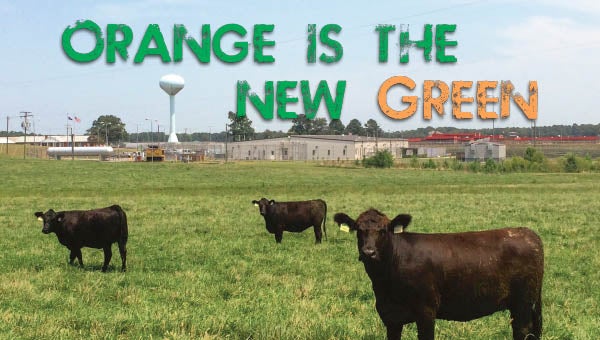Offenders grow crops at Southampton Prison Farm
Published 12:08 pm Saturday, August 8, 2015

In its 10 greenhouses, the Deerfield Agricultural Center produces the likes of lettuce, tomatoes, cucumbers and broccoli.
CAPRON
The image of a prison farm is typically that of several rows of prisoners in black- and white-striped uniforms tending the fields under the watchful eye of guards with guns in the dry, summer heat. Historically and theatrically, there is a truth to that perception. But at Deerfield Agricultural Center, also known as the Southampton Prison Farm, the purpose of the the agribusiness program is to provide jobs for non-violent offenders and train them so that they can find employment upon release from prison.
A 1955 edition of The Tidewater News notes that the farm opened simultaneously with the Southampton County Correctional Center when the Virginia State Prison Board in March 1937 purchased nearly 1,800 acres of cultivable land just three miles west of Capron. Inmates at the prison were tasked with clearing out brush and briars and building temporary structures so that the farm could function during its early years.
After enough crops were planted to feed the offenders and livestock, construction began on permanent buildings. The first building — made from sand on the farm molded to emulate a cement block — was a sweet potato storage house capable for holding roughly 5,000 bushels. Soon afterward, an underground Irish potato house, three poultry houses, a cattle lounging barn, a mule barn, a cotton gin, three smokehouses and other permanent buildings were finished.
By July 1951, the farm was producing more than it could use or sell to other institutions, so a cannery and two kilns were also erected.
The prison also purchased a number of livestock, including a purebred Guernsey bull, five cows, 45 pigs and sows and more than 100 hens. From this, a heard of purebred cattle and Hampshire hogs developed, and eggs were being produced year-round.
By 1955, more than 80 percent of all food consumed at the prison was cultivated or bred on the farm and temporary structures were being replaced by permanent buildings. A long-range construction program resulted in the addition of a heating plant, a sewage disposal plant, a dormitory, cell buildings, cyclone fencing, a warehouse, truck and equipment sheds, five staff houses, guards’ quarters and a mess hall. The erection of an administration building, laundry, maintenance shop, industrial shop and an additional cell building were in the works at this newspaper’s last visit.
With the physical facilities greatly improved, efforts were then focused on the lives of the hundreds of inmates at the correctional facility. To accomplish this, the record of every offender was reviewed and he was placed in farm work, construction or any other job suited to his skills.
“Everyone out here has some kind of job,” said Farm Manager Wes Blythe, noting that this remains in effect today. “They apply for a job and interview, and we hope to set them up in something that they have experience.”
John “Kenny” Raiford, Agribusiness Operation Director for the Virginia Department of Corrections, said that the job assignments serve two purposes.
“One, it gives the offender some kind of trade or skill while promoting good work ethics, and two, it reduces food cost for the prison system,” he said, noting that it costs $2.10 per day for three meals for each offender. “They’ll be able to walk out of here with certifications such as ServSafe, Beef Quality Assurance, Pork Quality Assurance, Commercial Pesticide Handlers Permits, forklift license or a commercial driver’s license.”
Some of the inmates could not read or write, so Southampton established an education program that would allow for inmates to work for half a day and attend school the other half. Some even completed their high school education.
It was also determined around this time that the institution would become a medium and minimum custody detention center for inmates of all races, and that only men with non-violent crimes and those non-sexual in nature could be assigned to Southampton. This policy, too, is still used today.
Prisoners were also able to purchase items such as cigarettes, candy, ice cream and toiletries of various types with their earnings. The profits from the twice-monthly sale would benefit the offenders in the form of athletic equipment, musical instruments, a movie projector, televisions, a piano and other similar luxuries.
While some of those luxuries are no longer afforded, as Raiford said that the facility became tobacco-free for staff and offenders in 2010, today’s inmates can purchase items such as sodas, snacks, art supplies, clothing, shoes, books, magazines, cosmetics, personal items and toiletries, or use their funds for child support, restitution, fines or a co-pay for doctor’s visits. The average pay at Southampton Work Center for Men and Pre-Release and Work Center for Women is 45 cents per hour, and offenders have the opportunity to save money for their inevitable release.
While the state prison was demolished in 2009, cutting almost 200 non-offender jobs in the process, the farm has continued to grow in size. Presently, the operation sits on more than 2,630 acres of land, and produces an average of 650 acres of crops per year. Hundreds of cattle roam the 330 acres of pasture, and a commercial pig farm houses 120 farrow-to-finish sows, a number of which recently gave birth.
Two hundred offenders — 120 female and 80 male — work in various jobs throughout the premises. The men work in the fields, livestock facilities, tractor shop, greenhouses, carpentry shop, pallet shop, grist mill or sawmill, while the women work in the flash-freeze facility. There, the produce that isn’t used at Deerfield is frozen and shipped elsewhere in the system.
“The prison is very important to the local economy,” Raiford said. “There are over 500 state employees working at the Deerfield Complex, and the prison utilizes numerous small businesses in Southampton and surrounding counties for goods and services.”





